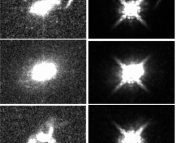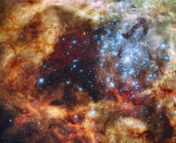• Title: No Evidence for Intermediate-Mass Black Holes in Globular Clusters: Strong Constraints from the JVLA
• Authors: Jay Strader, Laura Chomiuk, Thomas Maccarone, James Miller-Jones, Anil Seth, Craig Heinke, Gregory Sivakoff
• First Author’s Institution: Harvard-Smithsonian Center for Astrophysics
Last September, Maria wrote about “a lost middle sibling in the black hole family tree.” The black hole family tree, as Maria calls it, consists of two observed types of black holes. The first type consists of stellar mass black holes, which form during the death of a massive star and have masses on the order of 10 times the mass of the Sun. The second category of observed black holes consists of supermassive black holes, which lie at the centers of most, if not all, large galaxies, and have masses upwards of 105 times the mass of the Sun. Intermediate mass black holes (IMBHs) are proposed to have masses between these two values, but they have not yet been observed, and their existence is a topic of active research. In this paper, Strader et al. search for IMBHs at the centers of globular clusters at radio wavelengths using the Jansky Very Large Array (JVLA), a telescope in New Mexico composed of 27 radio antennas.
Expectations
So why would we expect IMBHs to exist? For one, most observed distributions are continuous, yet the black hole family tree is missing several orders of magnitude in mass. (I did say most distributions, however, not all; see Warrick’s post about the neutron star-black hole gap for an example of a non-continuous distribution). Another reason we might expect IMBHs to exist is that they may be fundamental to explaining the existence of supermassive black holes. Supermassive black holes are thought to grow over cosmic time from a population of “seed” black holes having initial masses in the IMBH range. There are various mechanisms by which such seed black holes could form, including the collapse of massive stars or direct collapse out of high density gas clouds (see these previous posts for more details). It is reasonable to expect that some of the seed black holes that initially formed did not accrete substantial amounts of matter, and thus never grew to be supermassive black holes.
IMBHs have also been suggested as an explanation for Ultra-luminous X-ray sources observed in some other galaxies; however, these sources can still be explained by other astrophysical phenomenon (see Maria’s post for more details). In order to continue the search for IMBHs, Strader et al. search for them in our own Galaxy. Because of proximity, Galactic IMBHs would be easier to detect than extragalactic ones. Furthermore, Galactic IMBHs may be associated with multiple observational signatures, which makes it easier to differentiate between different models. In particular, some researchers have suggested globular clusters as a possible site for IMBHs. Globular clusters are spherical systems of stars which orbit the centers of galaxies. While the formation of globular clusters is not well understood, it is believed that they are leftovers from an epoch of galaxy formation (e.g. West et al. 2004). Since galaxies and globular clusters formed at the same time, it is possible that at least some globular clusters may contain leftover seeds (IMBHs). Before we go any further, we should discuss the observational signatures that we expect to be associated with IMBHs.
Observational signatures of black holes
There are two primary signatures by which we can find black holes. The first method relies on the dynamical effect (i.e. how the black hole’s gravity affects the motions of objects near it). For example, the motions of the stars in the Galactic Center have been monitored, and have shown that a unseen object of 4 million times the mass of the sun must lie at the center of our Galaxy: a supermassive black hole. However, this effect scales with mass: the bigger the black hole, the easier it is to detect dynamical effects, and thus the dynamical effects from IMBHs are more difficult to detect. While there have been claims of IMBH detections in globular clusters, these detections would be more robust if combined with another detection method.
The second detection method for black holes relies on the properties of the accretion disk, the gaseous disk that collects around the black hole before the gas falls onto it. Because material must lose energy and angular momentum before being accreted by the black hole, accretion disks can be very luminous. For accretion disks, the broadband spectrum (i.e. the relative amount of emission at different wavelengths) has a very different shape than the broadband spectrum of a star, and thus detecting the luminosity from an accretion disk at multiple wavelengths (i.e. examining the spectral shape) is a good way to find black holes. The caveat it that the luminosity of the accretion disk is dependent on not only how much mass is being accreted by the black hole, but also by how effectively the disk radiates energy for us to observe. In other words, a black hole which is accreting a small amount of material ineffectively will appear dim regardless of its mass.
Detecting an IMBH by both dynamical effects and the accretion disk luminosity is ideal, since either observable property alone can be replicated by other effects. This fact motivates IMBH searches in nearby systems such as globular clusters, since proximity is necessary to detect dynamical effects from IMBHs.

The predicted IMBH masses for various radio brightnesses (fluxes) are shown for each of the observed globular clusters. The observational upper limit is shown between the lines in the 3 sigma range. As you can see, these IMBH upper mass limits lie below 1000 times the mass of the Sun for all of the globular clusters in this sample.
The Observations
Strader et al. observed three globular clusters at radio wavelengths to search for electromagnetic radiation from IMBH accretion disks: M19, M22, and M15. Each of these globular clusters was chosen because they were relatively massive and close, and they have properties associated with IMBHs. Radio wavelengths are a good choice for black hole searches because unlike accretion disks, most stellar sources do not emit much light at these wavelengths, making source confusion in globular clusters less of an issue.
Results
Strader et al. do not detect significant radio sources at the centers of M19, M22, or M15. These non-detections can provide upper limits on the luminosity (and thus mass) of the (potential) IMBHs at the centers of these clusters. To derive these upper limits, the authors make a reasonable set of assumptions about how IMBHs accrete, and predict how an IMBH’s mass is traced by its radio emission (see the Figure). The upper mass limits range between 360-980 times the mass of the Sun. However, if we remember back to the caveat of accretion disks, a low luminosity might simply indicate that the black hole is not accreting very much material, and not that it has a low mass. For this reason, Strader et al. conclude that either (1) IMBHs with masses more than 1000 times the mass of the sun are rare in globular clusters, or (2) IMBHs in globular clusters accrete inefficiently.
Future work
Strader et al. encourage the continued acquisition of radio observations in globular clusters so that the sample of potential IMBH hosts is increased. If a radio signature of an IMBH is observed in a globular cluster which exhibits an IMBH dynamical signature, these combined observations would provide very strong evidence in favor of the existence of IMBHs.





Trackbacks/Pingbacks